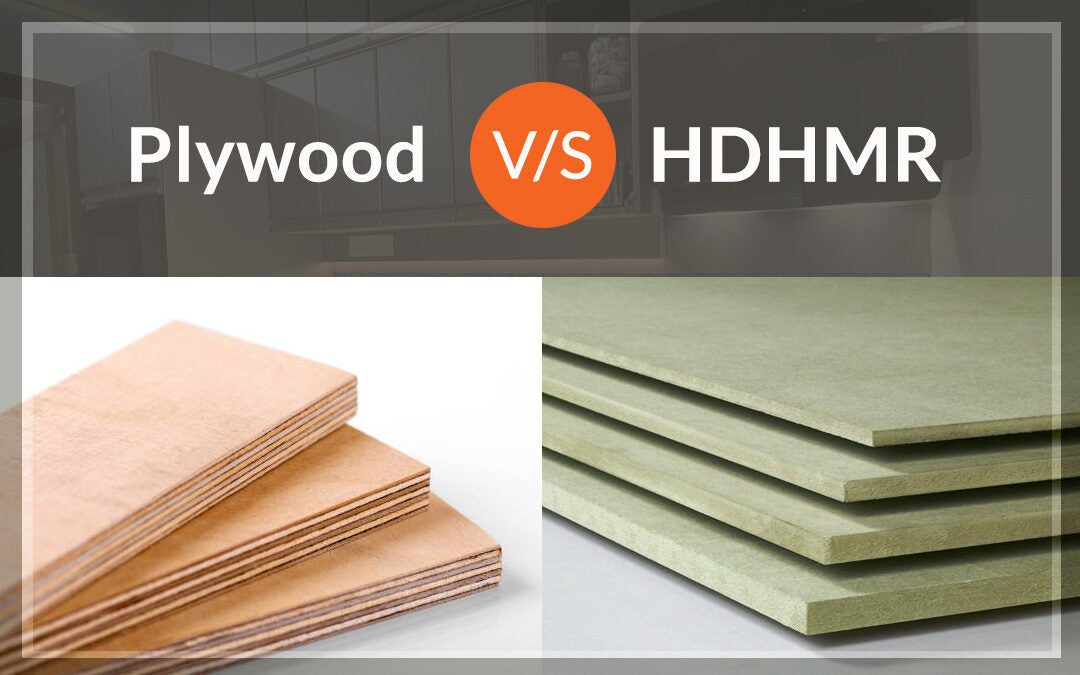
Plywood vs. HDHMR: Which One is Transforming Modular Kitchen Design?
Share
When designing a modular kitchen, the choice of material plays a crucial role in ensuring durability, aesthetics, and functionality. Among the various options available, HDHMR (High-Density High Moisture Resistant) board and plywood have emerged as two leading contenders. But which one is truly revolutionizing modular kitchen design? Let's delve into the debate of HDHMR vs. plywood and determine which is the better option for your kitchen.
Understanding Plywood and HDHMR
Before comparing the two materials, it is essential to understand what they are and their key characteristics.

What is Plywood?
Plywood is a composite material made by gluing multiple layers of wood veneer together with strong adhesives. It is available in various grades, including marine, commercial, and boiling water-resistant (BWR) plywood, each offering different levels of strength and moisture resistance.
Explore Kyzo’s plywood collection here.

CenturyPly Bond 710 BWP Plywood

KHIDKI Gold MR Plywood

Greenply Absolute MR Plywood

Greenply Absolute BWP Plywood

Greenply Club Flexiply BWP

Greenply Platinum BWP Fire Retardent Plywood

GreenPly Green MR

GreenPly Green GOLD BWP 710

GreenPly Green Ecotec BWP 710

GreenPly Ecotec MR

CenturyPly Architect Plywood

CenturyPly Club Prime BWP Plywood

CenturyPly WIN MR Plywood

CenturyPly Sainik 710 BWP Plywood

CenturyPly Sainik MR Plywood

KHIDKI Prime Plus Calibrated MR Plywood

KHIDKI Flexi Plywood (Imported) - 8ft x 4ft

KHIDKI Gold Plus Calibrated BWP 710 Plywood

KHIDKI Silver Plus Calibrated BWP 710 Plywood

KHIDKI Silver Calibrated MR Plywood (Neem Face)
Advantages of Plywood:
- High strength and durability
- Resistant to warping and cracking
- Available in multiple finishes and thicknesses
- Can be polished or laminated for aesthetic appeal
Disadvantages of Plywood:
- Prone to moisture damage if not properly treated
- Requires additional waterproofing for kitchen applications
- Higher cost compared to MDF and other engineered boards
What is HDHMR?

HDHMR (High-Density High Moisture Resistant) board is an engineered wood product created by compressing wood fibers with a unique adhesive under high pressure. It is specifically designed to withstand high moisture conditions, making it ideal for modular kitchens.
Advantages of HDHMR:
- Higher density than standard MDF and plywood
- Exceptional moisture resistance, making it suitable for kitchens
- Termite and borer resistance
- Smooth surface, allowing for better paint and laminate applications
Disadvantages of HDHMR:
- Heavier than plywood, making installation slightly challenging
- Less flexible than plywood, limiting intricate design possibilities
- Slightly higher cost than commercial plywood

Action Tesa Exterior Grade MDF (Red Color) - 8ft x 4ft

Action Tesa Boilo - 8ft x 4ft - Fire Retardant BWP HDF Board

GreenPanel HDWR Club Grade (Green Color) - 8ft x 4ft

GreenPanel MDF Exterior Grade (Red Color) - 8ft x 4ft

GreenPanel MDF Interior Grade (Brown Color) - 8ft x 4ft

Action Tesa HDHMR (Green Color) - 8ft x 4ft

Action Tesa Interior Grade MDF (Brown Color) - 8ft x 4ft

Kasawud HDHWR (Green Color) - 8ft x 4ft

Kasawud MDF Exterior Grade (Red Color) - 8ft x 4ft

Kasawud MDF Interior Grade (Brown Color) - 8ft x 4ft
HDHMR vs. Plywood - A Detailed Comparison
Now that we understand the basics of both materials, let's compare them based on critical factors.
1. Strength and Durability
Both HDHMR and plywood are strong and durable, but plywood, particularly BWP (Boiling Water Proof) grade, tends to have better load-bearing capacity. Plywood is less likely to break under pressure, making it suitable for heavy kitchen cabinets.
Looking for Khidki Gold MR Plywood
However, HDHMR board vs. plywood in terms of density shows that HDHMR has a denser core, reducing the chances of swelling and warping. This makes it a viable choice for moisture-prone areas in the kitchen.
2. Moisture Resistance
A modular kitchen is frequently exposed to water and humidity. While BWP plywood is water-resistant, it may still absorb moisture over time, leading to deformation.
On the other hand, HDHMR sheet vs. plywood in moisture-prone areas proves HDHMR to be superior. HDHMR boards have an inherently high moisture resistance, making them a more stable choice for kitchen environments.
3. Aesthetic Appeal and Finish
Both materials support laminates and paints, but HDHMR has a smoother surface compared to plywood, allowing for seamless finishes. If you are looking for a modern, sleek kitchen, HDHMR vs. plywood which is better? HDHMR boards might be the preferred option.
4. Termite and Borer Resistance
Plywood, if untreated, is susceptible to termite and borer attacks. However, HDHMR vs. plywood for kitchen in this regard favors HDHMR, as it is designed to be termite and borer-resistant from the start.
5. Cost Factor
When comparing plywood vs. HDHMR cost, standard commercial plywood tends to be cheaper than HDHMR boards. However, when considering long-term durability and maintenance costs, HDHMR vs. plywood price shows that HDHMR may provide better value over time due to its low maintenance and high resistance to moisture and pests.
6. Ease of Workability and Installation
Plywood is easier to cut, drill, and shape, making it ideal for customized modular kitchen designs. HDHMR sheet vs. plywood in terms of workability shows that HDHMR, being denser, is harder to cut and install. Therefore, if intricate designs and flexibility are required, plywood may be the better choice.
You can also look at Khidki Silver Plus Calibrated BWR Plywood
Which is Better - HDHMR or Plywood?
After analyzing the pros and cons, let's summarize the key takeaways:
- For moisture resistance: HDHMR is the better choice.
- For strength and durability: Plywood, especially BWP grade, is superior.
- For termite resistance: HDHMR wins.
- For aesthetic finish: HDHMR provides a better surface for painting and laminating.
- For affordability: Plywood is the more budget-friendly option.
- For customization: Plywood is easier to work with for intricate designs.
Therefore, HDHMR or plywood, which is the better one? The response is based on your individual assurance. If you want to have a water-resistant, termiticide-coated, and polished floor, HDHMR is your answer. Nevertheless, plywood is the better option if you prefer strong, fit-in design and cost-effectiveness.
Which Material is Transforming Modular Kitchen Design?

HDHMR boards are becoming the top choice in the modern modular kitchen design as they are more durable and provide a smoother finish due to their enhanced moisture resistance features. On the other hand, plywood is still the most popular product because of its durability and its ability to be easily flexed. The final choice will vary depending on the amount of money, the building design, and the kitchen specific requirements that a person or a family has. For those who want to enjoy their kitchen without taking much care, HDHMR is an ideal investment. Also, if you are a supporter of a cheap and effective material then the plywood will be the best choice. Be that as it may, the two types of material are continually bringing the creative ideas to a kitchen remodel and sometimes unique solutions are offered on a new kitchen and a family's new or greatly altered needs.
Conclusion
The materials are considerations to put in mind for the kitchen. For example, when both aesthetics and money are considered, the select ion of the best one will be made. Both materials are good but they are used for different modular kitchen applications. It is good to get advice on combining kitchen spaces with dryness and effectively resolving the problem of termites. But if you prefer hardwood, you can go on with it. If it is hard to decide, ask yourselves the right questions so that your kitchen will offer the comfort you need.
FAQs
Q1. Which is best, plywood or HDHMR?
Ans. It depends on the application. HDHMR is better for moisture resistance and termite protection, while plywood is stronger, more flexible, and easier to work with for custom designs.
Q2. What are the disadvantages of HDHMR board?
Ans. HDHMR is heavier, less flexible, costlier than commercial plywood, and harder to cut for intricate designs.
Q3. Is HDMR sheet waterproof?
Ans. HDHMR is highly moisture-resistant but not entirely waterproof. Prolonged water exposure can still cause swelling.
Q4. Is HDHMR 100% termite proof?
Ans. HDHMR is termite and borer resistant, but no wood-based product is 100% termite-proof in extreme conditions.
Q5. What are the disadvantages of plywood?
Ans. Plywood is susceptible to moisture damage, requires additional waterproofing, and can attract termites if untreated.
Q6. Can we use HDHMR in the kitchen?
Ans. Yes, HDHMR is ideal for kitchen cabinets and furniture due to its moisture and termite resistance.



